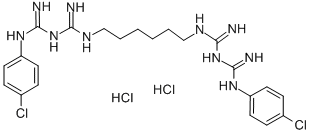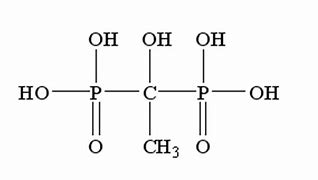Chlorhexidine Hydrochloride: Clinical Applications in Dentistry and its Adverse Effects
General Description
Chlorhexidine hydrochloride is an essential agent in dentistry, known for its therapeutic and prophylactic applications, particularly in combating oral bacteria through mouthwash, gel, and varnish formulations. While effective in reducing plaque and combating pathogens, its efficacy depends on concentration and proper usage timing, especially concerning potential interactions with toothpaste ingredients. Despite its benefits, chlorhexidine hydrochloride has associated adverse effects, including taste alterations, xerostomia, and cosmetic issues like tooth staining. Additionally, concerns about antimicrobial resistance and hypersensitivity reactions necessitate cautious use by practitioners. Further research is essential to optimize its use alongside fluoride and to understand resistance mechanisms.

Figure 1. Chlorhexidine hydrochloride
Clinical Applications in Dentistry
In dentistry, Chlorhexidine Hydrochloride(CHX) products are used therapeutically as well as prophylactically. For these purposes, the ideal dosage of CHX is 18 to 20 mg per application, which maximises efficacy whilst minimising side effect.
Presurgical: Utilise 0.12% or 0.2% Chlorhexidine Hydrochloride preoperative rinse for 1 minute to reduce oral microbial load prior to implant placement.
Postoperative (short-term maintenance): If toothbrushing is not possible due to postoperative pain, it is recommended that a 0.12% to 0.2% 1-minute rinse is performed 3 times a day for 7 days or until sutures are removed and oral hygiene in the form of toothbrushing can resume.
Postoperative (long-term maintenance): Locally administered sustained-release Chlorhexidine Hydrochloride, in the form of CHX chips, may be considered for use as an adjunct to nonsurgical treatment of peri-implant mucositis and peri-implantitis. Specifically, the use of Periochip over a maximum of 6 months has been suggested in the reduction of implant pocket depth, with a minimum of 2-week recalls.1
Compatibility with Fluoride
Historically, researchers have explored the compatibility of chlorhexidine hydrochloride with fluoride, aiming to harness the beneficial properties of both agents for oral health. While initial studies suggested that certain fluorides could eliminate a significant portion of free chlorhexidine hydrochloride, resulting in a belief of incompatibility, recent findings regarding sodium fluoride indicate otherwise. Sodium fluoride appears to maintain its efficacy alongside chlorhexidine hydrochloride without diminishing its antimicrobial effects, forming a compound known as chlorhexidine difluoride when combined. This combination potentially retains both the plaque-inhibiting benefits of chlorhexidine hydrochloride and the remineralizing properties of fluoride. However, ongoing research is necessary to fully understand their interaction and whether chlorhexidine hydrochloride influences fluoride’s effectiveness. Until more definitive clinical studies are conducted, the simultaneous use of chlorhexidine hydrochloride and sodium fluoride mouthwash remains a topic of investigation in enhancing dental care practices. 2
Adverse Effects
One evolving issue with the use of Chlorhexidine hydrochloride is the development of antimicrobial resistance (AMR), which is a serious adverse effect. Low-level exposure to CHX may cause cross-resistances to antibiotics. Moreover, some mechanisms that allow for resistance of CHX in bacterial organisms include efflux pumps and mutations in the cell membrane structure. Multidrug resistance and virulence are growing in ESKAPE pathogens which include Enterococcus faecium, Staphylococcus aureus, Klebsiella pneumoniae, Acinetobacter baumannii, Pseudomonas aeruginosa, and Enterobacter spp. The Infectious Diseases Society of America has labeled them as ESKAPE pathogens because they are capable of escaping the MOA of antibiotics and eventually developing resistance. These pathogens are the number one reason for the development of hospital-acquired infection, or nosocomial infection. In fact, E.faecalis plays a critical role in the development of endodontic infections. When this species is found in the form of biofilm, it is considered one of the most resistant species in oral cavity, due to its resistance to Chlorhexidine hydrochloride and sodium hypochlorite. However, little is known about the risk of resistance to CHX in oral bacteria and cross-resistances to antibiotics; therefore, future research should focus on related effects of CHX on bacteria in oral biofilm.
References:
[1] FRANK POPPOLO DEUS A O. Chlorhexidine in Dentistry: Pharmacology, Uses, and Adverse Effects[J]. International dental journal, 2022, 72 3: 261-420. DOI:10.1016/j.identj.2022.01.005.[2] TA ELKERBOUT. Will a chlorhexidine-fluoride mouthwash reduce plaque and gingivitis?[J]. International journal of dental hygiene, 2018, 17 1: 1-93. DOI:10.1111/idh.12329.
Lastest Price from Chlorhexidine hydrochloride manufacturers

US $1.00/KG2025-04-21
- CAS:
- 3697-42-5
- Min. Order:
- 1KG
- Purity:
- 99%
- Supply Ability:
- 10 mt

US $180.00/kg2025-04-15
- CAS:
- 3697-42-5
- Min. Order:
- 1kg
- Purity:
- 99%
- Supply Ability:
- 20ton


